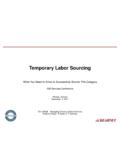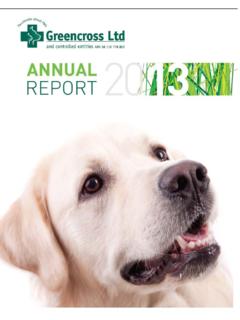Transcription of The Power of Six Sigma in Procurement
1 Debbie Beavin, CPOD ecember 3, 2010 The Power of Six Sigma in ProcurementISM Services Conference Discussion Points A Humana Inc. Overview Fueling Innovation and Growth Six Sigma at within Procurement Lessons Learned2 Our DreamHelp People Achieve Life-long s Well-Being ApproachThe Full Spectrum of Well-BeingLiving happily with a balanced sense of purpose, belonging, security & healthPurposeServiceVocationalAdvocacyBe longingSocialCommunityFamilyHealthPhysic alEmotional SpiritualSecurityFinancialPersonal SafetyFamilyEnvironmental4 TransformationRevenue | $31 BNursing HomesIn 1961, two young lawyers from Kentucky, David A. Jones and Wendell Cherry, had started a nursing home and Cherry plus 4 other partners created Heritage House and Extendicare. By 1968, the company owned 7 nursing business in the early 1980's Humana had become the largest hospital company in the world owning over 80 hospitals around the globe. Hospitals were spun off into a separate entity in plansHumana expanded into the health insurance industry in 1984, offering affordable HMO plans.
2 Humana currently offers a range of health plans for the needs of individuals, families, and businesses. Located in Kentucky with headquarters in Factors Manufacturing EconomyKnowledge EconomyGoodsInformationIntelligenceProdu ctivityEfficiencyEffectivenessEquipmentH uman CapitalCollaborative EconomyExperienceEngagementInnovationSoc ial Capital6 Fueling Innovation and Growth Personal NurseSmartSummaryHumanaAccess CardRightSource, prescription mail order deliveryMyHumanaTools:Physician Finder Family Health Budget Enrollment WizardHumana Commitments Commitment to associate value principle Perfect service and engagement Collective responsibility for prioritizing business initiatives Everything considered / everyone plays Sustainable long-term view A focus on talent8 Collective Responsibility for Prioritizing Business InitiativesThink few. Concentrate on the essentials. Figure out what to sharply-pointed rather than well-roundedAlign with the Strategy. Pursue the toward the sun Identify the value drivers in your organizationGet your team engaged as business peopleEveryone needs to be sufficiently informedCirculate.
3 Link people up. Orchestrate Considered / Everyone PlaysAll leaders demonstrate appropriate use of Humana's resources and financesBehave like you re in business for yourselfSavings opportunities are everywhereListen up, leader. Ask your teamFocus on adapting and thrivingModel adaptability10 Six SigmaAt Humana Sigma Process Improvement MethodologyDefineMeasureAnalyzeImproveCo ntrolWhat s important to the customer? VOC Research Customer CTQsWhat s the business Case? Process Understanding ScopingWhat s in it for me? What s the Plan? Project Plan and Charter Team Communication PlanHow is performance measured? Define Data Type(s) Operational Definition(s)Do you have good data? Potential X(s) Measurement System Analysis Determine Appropriate Sample Data Collection Plan What is the baseline? Descriptive Statistics Capability Analysis Performance GoalWhat X(s) matter most to the goal? Descriptive Statistics AnalysisWhat is the impact on the Y? Inferential Statistics AnalysisWhy are these X(s) happening?
4 Descriptive Statistics Capability Analysis Performance GoalDo these X(s) influence the Y? Demonstrated RelationshipWhat is the solution? Solution Screening Solution Refinement Did the solution work? Statistical Pilot Results CBAHow will we ensure Controls for Vital X(s)What if something goes out of control? Control Plan Tracking for Y(s) and X(s) Transfer to Process Owner Project Validation ScheduledVALIDATION:What did we learn and next steps? Final Documentation andSignoff Lessons Learned Follow-Up Projects Team Celebration12 Practical Review of Six Sigma : 6 BasicsUnsafe drinking water almost 15minutes out of each day Practical Meaning of 99% Good 20,000 lost articles of mail per hour 2 short or long landings at most majorairports each day No electricity for almost 7 hours eachmonth3 CapabilityHistorical Standard 4 Capability Current Standard 6 Capability New Standard (Distribution Shifted )2308,537366,80746, PPMPPMP rocessCapabilityProcessCapabilityDefects per MillionOpportunities1.
5 What is Six Sigma ?DMAIC RequirementsProject/Student requirements6 Basics13 Process Improvement PhasesDefine Clarify the problem to be solved, identify the key stakeholders and customers, develop a clear charter relevant to customer needs. Measure Document baseline performance of the process related to the problem, validate the Identify root causes (the Xs ) of the problem and quantifies their effect on process -- Develop, select and test best solutions while minimizing the risk of -- Ensure the solutions are permanently embedded in the process with robust controls to ensure sustainability and consistency. Sponsor reviews are conducted as part of the sign off for each phases6 Basics1. What is Six Sigma ?DMAIC RequirementsProject/Student requirements14 DMAIC Project Requirements Strategic Alignment Return on Investment Problem is clear - Solution Unknown Project Scope and Training Cycle Geography (complexity, location(s), areas impacted) Support Data6 Basics1.
6 What is Six Sigma ?DMAIC RequirementsProject/Student requirements15 DMAIC Student Requirements Process/Work Experience Process Analysis Role Time Commitment Sponsorship Passion6 Basics1. What is Six Sigma ?DMAIC RequirementsProject/Student requirements16 Effective Goal Statements Describe desired/planned new performance Are as objective as possible Are also brief and use common vs. tech. terms Do not include causes or imply solutions May include estimates or placeholders (x%) Are often reviewed after Measure & Analyze[example: Our deliveries must be within +/- I hour 98% of the time by year end] Specific- The goal should be exact regarding what the team hopes to accomplish. Measurable- So the team knows exactly when the goal has been achieved. Achievable The goal is something that can be achieved in the scope and timeframe of the project. The goal is neither too ambitious nor too trivial. Relevant The issue is significant to the business. Time Bound- The time frame should be achievable yet limited enough to make the goal valuable to the company.
7 Goals17 Capturing Plans and Tracking Progress Team Charter Name of Team: Date created/updated: Developed by/Contact person: Problem Statement: (The As Is Statement : One sentence explaining what problem or need the team is being formed to address. Remember to make the Problem and Goal statements SMART: Specific, Measurable, Attainable, Relevant, Time-bound) Objective/Goal: (The Desired State Statement: One sentence explaining what the goal or objective is related to the Prob lem Statement above. State how success of the team will be measured. What will be the specific, measurable results? Remember to make the Problem and Goal statements SMART: Specific, Measurable, Attainable, Relevant, Time-bound) Background: (Briefly explain what led to the need for this project. Explain any history that would be applicable to understanding the problem or need. State the problem or need with data in terms of customer service, financial impact, and/or productivity.)
8 Include current compared to targeted performance and any costs associated with the problem. Use data from a Cost/Benefit Analysis, if one was prepared) Business Area: Business Strategy Supported by this Project: (State how this effort relates to our vision, value proposition, purpose, core beliefs, or strategies) Scope: (Define the boundaries of the project. Where does this project start and end? What is specifically not included under the scope of this project? To which customer segments/work locations does this project apply? Which product lines are impacted? Which systems are included? Understanding the scope helps prevent scope creep ) Customers and CTQs: (List the Major Highest Priority Customers and CTQs that will be addressed by this project. Describe the customer-defined requirement(s) that will be improved by this project.) Interdependencies: (List functions or projects that are dependent upon or will be affected by the actions of this team) Anticipated Benefits (Financial/Other): (Describe benefits from successfully completing this project, including business growth (revenue enhancement), cost savings, cost avoidance, productivity improvements, and customer satisfaction improvement) Time Line/Key Milestones: (List key dates of the project.
9 Examples: Start and stop date of the project, when the view of the system will be completed, when the current process analysis will be completed, when the solutions will be identified, when recommendations and a time-line will be presented to sponsors) START DATE: COMPLETION: Team: Role Sponsor/ Champion: Leader: Team Members: Project Manager: Facilitator: Customer: Name (person with ultimate ownership of project) (person with overall responsibility for the project including assuring results are achieved) (people assigned to the team to contribute knowledge and expertise, participate at all meetings, and complete assignments as directed) (optional person assigned to support leader by managing project to stated timelines) (optional person assigned to mentor leader/team regarding processes and tools used by the team) (the recipient of the process output) Department Performance Indicator: (Run or bar chart showing current and targeted performance - to measure results of the team) Manager/Supervisor: ____[insert typed name]_____ Sponsor/Champion: ____[insert typed name]_____ ____[signature]_____ ____[signature]_____Concierge Savings-$200,000$0$200,000$400,000$600,0 00$800,000$1,000,000$1,200,000 Jan-03 Mar-03 May-03 Jul-03 Sep-03 Nov-03 Jan-04 Mar-04 May-04 Jul-04 Sep-04 Nov-04 Jan-05 Mar-05 May-05 Jul-05 Sep-05M onthsSavingsGross SavingsDirect SavingsNon-direct SavingsThe CharterThe Continuous Improvement Story18 Quality Engineering: Enterprise Support19 Quality Engineering.
10 Scorecard20 Six SigmaWithin Procurement21 Negotiate with all suppliers Narrow supplier pool to a short list for further negotiations Lead final negotiation/select suppliers Finalize terms, conditions, Service Level Agreements (SLAs), and performance requirements Develop contractInternal AnalysisExternal AnalysisSourcingProcessNegotiationsAnd ContractsImplementationCategoryManagemen tHumana s Six-Step Procurement Process Analyze spend Analyze usage and transactions Analyze/engage stakeholders and users Analyze products, services, and related contracts Analyze supplier and client relationships Map current processes/ identify process improvement Broadly define scope, specifications, requirements Identify potential sources of supply Evaluate supply markets Perform benchmarking analysis Evaluate macro-economic factors Refine scope, specifications, and requirements Consider potential process redesign Develop sourcing strategy Coordinate and manage stakeholders Develop evaluation tool/model Develop rollout plan, communications strategy, and end-user training/ support plan Begin transition to new supplier and/or process Execute rollout plan, communications strategy.


